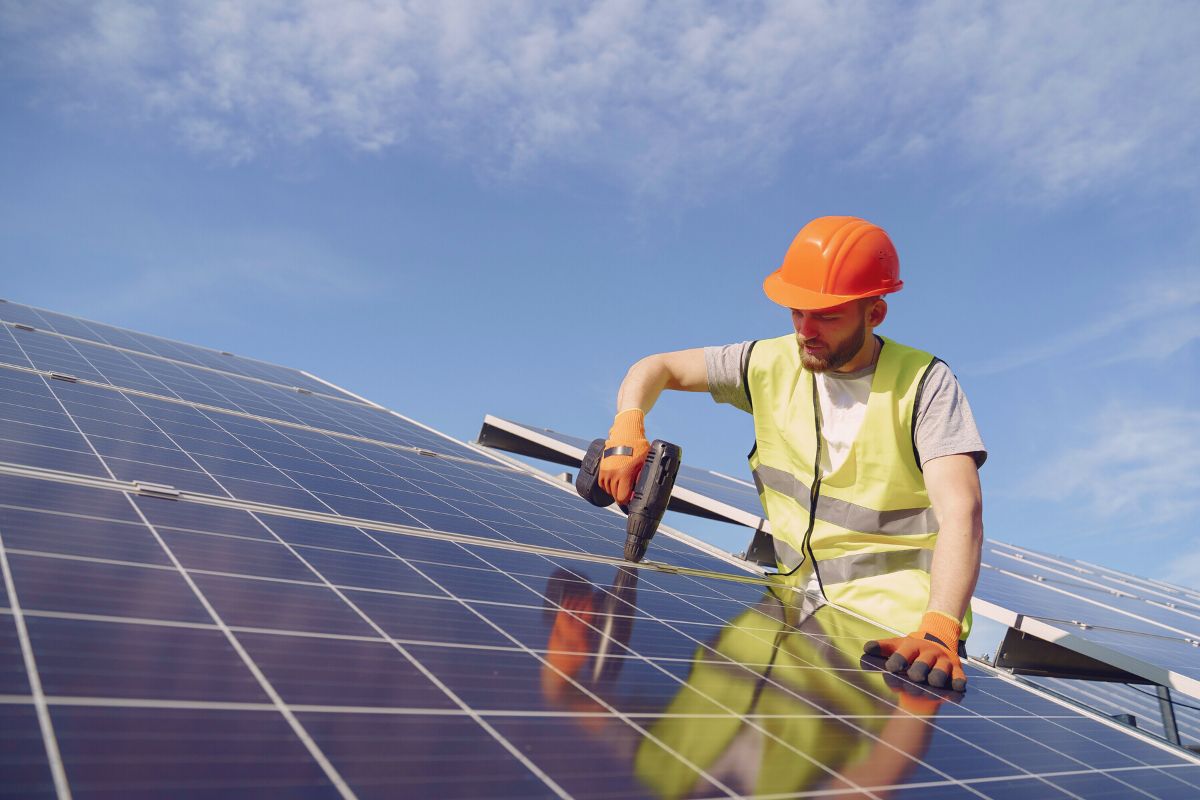The Ultimate Guide to Solar Panel Protection: What You Can Do Today
Installing solar panels was the best idea you came up with for having a reliable power supply.
However, the installation was only the first part.
We’ve highlighted several solar panel protection methods that’ll help you protect your power investment from internal and external damage. This includes multiple natural threats to your solar panels, such as birds, hail, and even lightning.
And while you can handle some of these on your own, others will require you to seek the services of solar professionals to hack.
Let’s dive in…
1. Solar Panel Bird Proofing: How to Keep Feathered Critters from Your Panels
Pigeons are the most common visitors that nest and leave droppings all over your panels. As annoying as this is, the damage may still go as far as scratching your panels.
Given that…
Bird droppings can erode your panel’s components, and scratches on your solar panels reduce their energy production.
Solar panel pigeon protection is one of the first protection measures if you live near nesting birds.
Do this by covering the perimeter of your solar panels with wire mesh or bird netting.
Now, as technical as this sounds, solar panel protection from birds is as easy as installing a fence. You can even do it yourself.
Setting up mesh/bird netting will prevent birds, like pigeons, from nesting under your panels by covering the space between the roof and the panel.
For more tips, head over to our earlier article on how to de-pigeon your solar array.

2. How to Protect Solar Panels from the Weather?
Bad weather can be destructive. Still, you’ll be surprised that your solar panels are not under any serious threat (most of the time), even when the rains fall hard.
Solar panels are waterproof, meaning they mostly can’t get damaged by rainwater. On the contrary, the water actually helps wash off dirt or debris from the panels’ surface.
But…
Bad weather doesn’t only mean a heavy downpour. There are other notorious weather threats to the life of your solar panels.
For example, intense lightning and hailstorms.
Here is how to protect your solar panel from hail and lightning damage if you live in an area prone to those conditions. Which is basically everywhere!
Solar Panel Lightning Protection (+ Minimizing the Risk of Strikes)
You’ve heard the saying that lightning doesn’t strike the same place twice. Nonetheless, ruining your entire solar panel system only takes one strike.
Many people debate whether they need solar panel lightning protection, and the answer is always yes.
If you don’t take the necessary grounding/earthing requirements for your solar panel protection, your solar panels could get damaged from lightning strikes. Granted, such cases are pretty rare, but rare is still a long way from impossible.
Most times, it’s the installing technician’s job to check your electrical and solar panel system grounding.
The technician connects a wire from the solar panels to the metal rack holding them, then to a rod that runs into the ground.
This acts as a lightning arrestor.
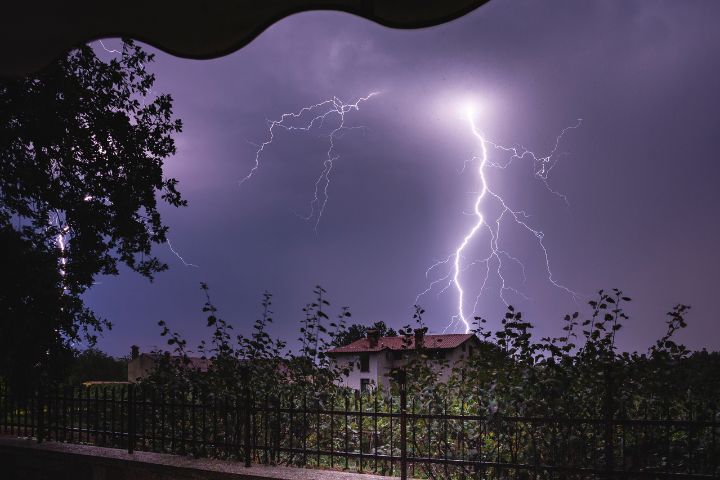
Grounding is also meant to protect your home’s inhabitants from getting zapped if they accidentally or knowingly touch a live wire in your electrical system.
This is common for worn-out electrical wire systems. The grounded copper wire detours the current to a safer path away from the person.
Note that most warranties don’t cover electrical strikes that damage your solar panels, so you better insure yourself against this pain-in-the-neck natural occurrence.
What About Hail? 6 Ways to Guard Against Ice Bombs
Severe hailstorms can damage windows and windshields, but solar panels are technically made to withstand a regular hailstorm.
Hail is simply water that freezes and falls as pea-sized ice droplets. Their size only increases if they accumulate water on their way down, to become as large as baseballs sometimes.
And that’s exactly where the problem lies. Take an ice baseball and throw it from the sky so its mass gets bigger as it sucks up more water. The growing mass gains in acceleration. So by the time it falls down, the effect on your panel may be pretty serious.
The little hailstones gradually form microcracks on your solar panels, which you won’t notice after the first few hailstorms.
As time goes on, however, these tiny cracks could open up to wide, ugly gorges on your solar panel – and that’s a misfortune you don’t want befalling yourself.
How much damage the hail causes to your solar panels depends on at least these 3 factors:
- Your solar panels’ position on the roof
- Your solar panel technology
- The duration of the hailstorm
You must consider a long-term method to protect your solar panels from hailstorm damage if you want them to stay effective and avoid counting your losses after a colossal hailstorm.
Here are a few tested and proven ways to curtail solar panel hail damage:

1. Monitor the Weather Forecasts
If you live in a region susceptible to hailstorms, you should make the weather forecaster your best friend.
Either monitor the weather forecast the old-fashioned way, on TV or the internet or use monitoring apps/software to anticipate the storms.
In doing so, you can prepare and implement relevant solar panel prevention techniques before the storm hits.
2. Apply a Methacrylate Coat
Methacrylate is a polymer plastic/plexiglass shield that coats your solar panels’ surface. This transparent layer protects your solar panels from the harsh impact of strong hail.
Since methacrylate forms a transparent layer, it doesn’t block sunlight from reaching your panels. It can be sprayed onto your panels or added as a thin coat.
Only avoid the parts that conduct electricity and apply the right amount. Too little is no use, and too much blocks the sunlight.
3. Use Protective Covers
Alternatively, you can always use protective covers made of clothing or hard shells to protect your solar panels from the impact of hailstones.
Cloth covers must be adequately hinged to avoid coming off during strong winds.
The only con to this method is that these covers don’t let in sunlight, so you must remember to uncover your solar panels afterwards.
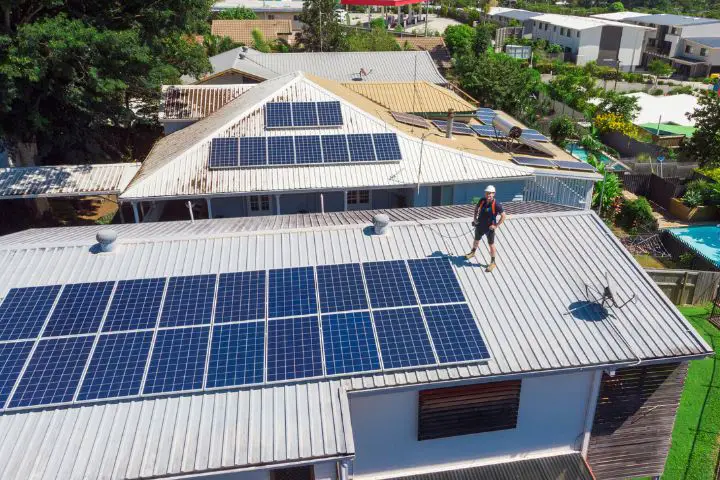
4. Add a Wire Mesh Cover
Wire mesh solar panel protection is one of the most affordable methods of protecting your solar panels from hail.
Instead of covering the sides as we did for solar panel bird proofing, the mesh goes over your panels.
The downside of wire mesh is that it can leave spaces for smaller hailstones. On the other hand, the advantage is that you don’t have to dismantle it after a storm, as it lets sunlight through.
5. Adjust the Angles of Your Solar Panels
To avoid maximum solar panel hail damage, you can install automatic angle adjusters that shift the positioning of your panels.
You need to reposition the panels after the storm passes to ensure maximum energy collection.
You can also check out our guide on how to take care of your panels during winter when the temperatures fall with the snow.
6. Impact-Resistant Solar Panels
Lastly, you could always use solar panels designed to withstand hailstorms.
These panels are constructed with durable materials and reinforced glass, making them more impact-resistant. This also means a hurricane will leave them unscathed.
This includes PV modules that put up a much better resistance to forceful impact than their glass counterpart, according to a report by Charlie Gay, the former Solar Energy Technologies Office Director at OEERE (Office of Energy Efficiency and Renewable Energy).
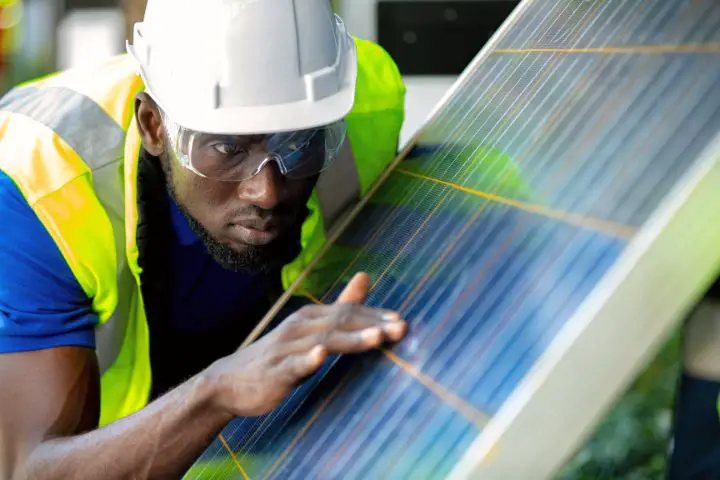
3. Bonus Solar Panel Protection Measures
External, natural forces are one thing. But what about the enemy within – like internal system damage?
And where there are wires and currents, there’s also a risk to the person who’s installing or maintaining your solar panels.
Mind the Edges!
The edges of your panels aren’t just about an odd rodent who might fancy munching on a wire or two.
It’s also about decreasing the chance that someone might slip and fall off the roof while maintaining.
Solar panel edge protection involves installing a barrier on the edge of your roof to prevent moisture from entering the internal circuit and strengthen the panel structure.
You can do this by applying a silicone sealant or edge protector to seal and reinforce the edges of your solar panels.
Solar Panel Reverse Current Protection
Sometimes, your solar power cells can discharge power which flows back into the main electrical grid.
This is known as a reverse current or a reverse current flow and can damage your panel regulator or disrupt the local grid’s stability.
According to a study on reverse currents’ effect in 2011, researchers found evidence proving that varying levels of reverse currents play a major role in harming/degrading the power, efficiency, and performance of solar panel modules.
Consult your solar panel technicians to install a regulator between the charge controller and the panel to protect your system from reverse currents. (More on solar charge regulators in this article!)
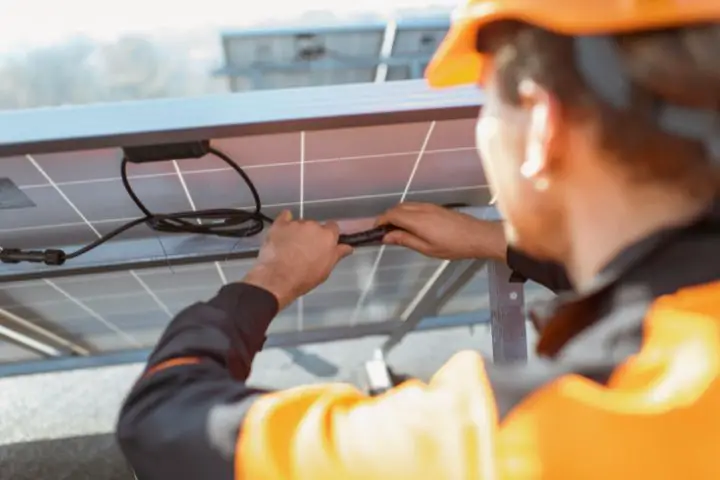
Solar Panel Inverter Grid Protection
Your solar panel inverter grid is yet another thing that needs an extra safety layer to protect it from lightning and power surges.
According to SECO energy experts, “members who own, or are contemplating the installation of a solar system, (should) incorporate quality surge protection devices (SPDs) into the design.”
You can use grid-tied inverters designed to synchronize with the larger electrical grid.
These inverters have built-in protection mechanisms and monitoring capabilities, ensuring seamless power integration and safe operation.
Solar Panel Protection – FAQs
Are Solar Panels Waterproof?
Yes, solar panels are waterproof, so water cannot get through to damage the system.
The panel’s outer layer is covered with a durable, double-layered polymer held by a metal frame and glue to keep it watertight (even in the harshest storms).
What Are the Best Hail-Resistant Solar Panels?
The best hail-resistant solar panels are usually marked “UL 61730” or “IEC 61730” in most retail markets.
These solar panels are tested to withstand hail speeds of up to 88.3 mph (142 kph) and hailstones as big as three inches in diameter.
They only require solar panel hail protection as additional damage preventive measures.
Before installing, you can also use this hail test certification to check if your new panels can withstand high winds and heavy snow loads.

